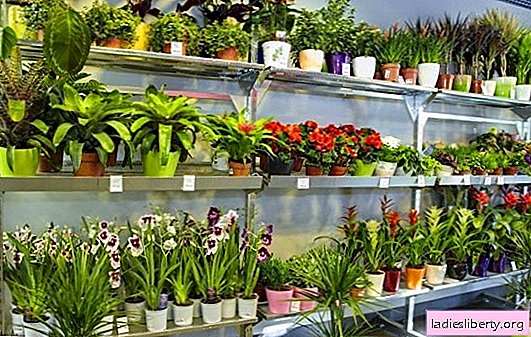
Smart advisers recommend buying indoor plants only in specialized stores. But the desire to get a beautiful flower appears in the supermarket, where we usually go much more often. To please yourself with a pleasant purchase is definitely worth it, but you will have to be especially vigilant.
Firstly, you can’t take in the armful of the first flower on your way and carry it to the cashier. And secondly, at home such an instance needs increased attention. Indeed, in a supermarket the living conditions of the plant are often worse than in a flower shop.
Choose wisely
In supermarkets, it is appropriate to look for seasonal flowers.
- Beginning of autumn - time of plants with decorative fruits. Buy indoor pepper, kumquat, nerter.
- For the new year holidays It is worth buying a poinsettia or Christmas cactus to Schlumberger. This is also the time of cyclamens, azaleas, amaryllis.
- In the spring the best time to update your collection of indoor plants. For no reason, take a hibiscus of the original color or a catchy Kalanchoe bush on a supermarket shelf. Acquire hyacinths or evening primrose to congratulate loved ones on February 14 or March 8. Or please yourself dotted with bright inflorescences of Ripsalidopsis during the Easter period.
Some plants are appropriate to buy at any time of the year. For example, the undemanding ficus of Benjamin or the charming phalaenopsis orchid. The attracted flower is carefully examined. It is better to refuse the purchase if:
- the plant has rotten patches on the stems and leaves;
- spots, burns, a raid of unknown origin on any part of it are visible;
- the roots are weak, the flower is unstable located in a flowerpot;
- pests were noticed on the substrate, stems, leaves;
- the soil in the pot is very wet, moldy.
The healthier the product looks, the lower the risk of encountering problems when growing a flower in the future.
Even before the acquisition, you need to think about where the new representative of the plant world will stand. This is especially important for plants that like a lot of light. For example, variegated ficus or vanda.
Drive home and quarantine
When transporting a flower, make sure that it does not fall during the first braking. In the cold season, you need to wrap the plant in several layers of paper before going out.
After all, for example, gardenia or phalaenopsis can lose flowers even at a temperature of +12 degrees. And if the day is frosty, it is advisable to spend as little time as possible in the fresh air so as not to freeze the plant.
At home, the flower is not unpacked immediately. It is left for 30-40 minutes, and then the shipping wrapper is carefully removed.
Determine a place for a new resident:
- bright, not stuffy room;
- away from direct sunlight in the summer and heating appliances in the cold season;
- without drafts.
ATTENTION! You can not put a new plant next to the green inhabitants already living in the house.
We need a two-week quarantine, during which the flower is closely monitored. It is during this period that latent diseases can manifest themselves. And if the plant is infected with parasites, then traces of their vital activity will become visible.
The first home watering is carried out depending on the state of the soil in the pot. If the soil is moist, it is best to moisten after 3-4 days. No need to bother the flower once again during quarantine, constantly rearrange the pot, pick off damaged leaves or inflorescences. Let the plant gently get used to the new place. After all, most likely, indicators of illumination, humidity and temperature have changed compared to those in the supermarket.
Do I need a transplant?
“Without pity, remove all buds and inflorescences from the purchased plant and transplant it immediately” - such tips can often be read on the Internet. How so?
Need to cut off all the beauty for which a bright flower was bought at the supermarket? Yes, sometimes there is such a need. An urgent transplant is needed if the flower dies before our eyes. When the soil is covered with mold, you can not do without this procedure.
Usually an emergency measure is not required. You can easily wait a few weeks until flowering ends. Or a few months, if the street is the end of December. Or a couple of years for a flower that grows in suitable soil and feels great. And then calmly transplant the plant. It is advisable to renew the land in the pot one month after purchase if the substrate consists only of peat or the flower is closely in the flowerpot.
You can perform a more gentle plant transplant - transshipment. This method is appropriate to use if the old soil is of high quality. True, such a pleasant surprise is quite rare in plants from the supermarket.
During transshipment, the roots are not completely freed from the old soil, but only part of the substrate is slightly removed. Then the plant is transferred to a new pot. Often flowers in supermarkets are sold in unattractive pots. Replanting for this reason is not necessary. It is enough to place the container with the plant in a beautiful flower pot to give the new thing a pretty look.
Extra care after purchase
Changes in the appearance of a flower during quarantine can report a variety of problems. In this case, additional measures will be required.
- Bacterial and viral infections often activated with improper care. Powdery mildew, rot, scab, late blight not only spoil the attractive appearance of the flower. They can lead to his death, if not help the plant. For treatment, special fungicides are used, they are selected depending on the disease.
- Get rid of a small amount of pests You can folk ways. If there are a lot of parasites, or the condition of the flower quickly worsens, chemical preparations are used. Spraying with acaricides or insecticides is performed with caution. Follow the instructions, because such drugs can have a toxic effect on humans.
The first pruning is done no earlier than a few months after purchase. Faded inflorescences and dry leaves are removed regularly. It is wonderful if, after quarantine, the flower retains an attractive appearance, does not suffer from pests and diseases. Over 2-3 weeks, he will gradually become accustomed to the correct water regime and a new place. If a transplant has not been carried out, then about a month after the housewarming, the plant can be fertilized.











